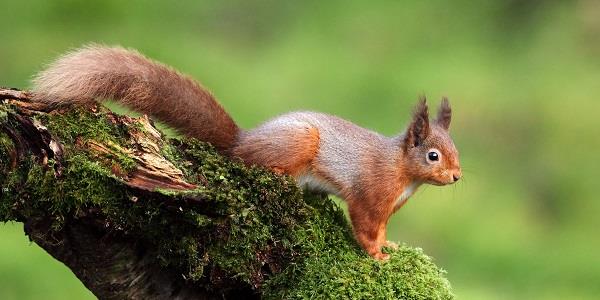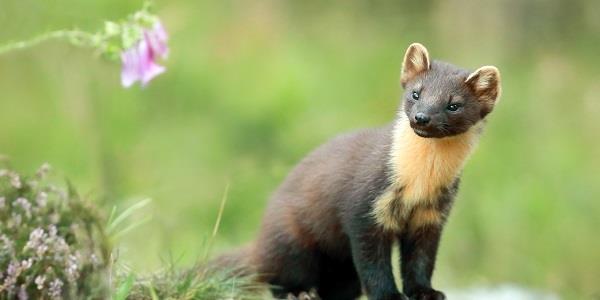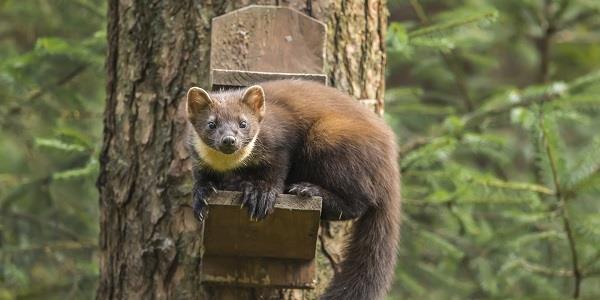
After over a century of decline following the introduction of their grey American cousins in the 1870s, the UK’s red squirrel population is on the rise. Not all across the land, maybe – but there are ‘pockets’ of Great Britain where small communities of Sciurus Vulgaris are not just surviving, but thriving.
Grey squirrels mean the reds no harm – but they unfortunately carry a disease, the parapoxvirus, harmless enough to the carriers but fatal to our natives.
However, in places where the ‘grey threat’ is nonexistent, or much diminished, red squirrels are doing just fine, thank you very much.
 Nutkin gained: red squirrels on the rise
Nutkin gained: red squirrels on the rise
On Brownsea Island off the Dorset coast – featured in a previous blog – the island’s isolation has allowed the red-squirrel colony to co-exist peacefully enough with Brownsea’s other ‘animal attractions’: sika deer, peacocks and visiting migratory birdlife, such as avocets.
Meanwhile on Anglesey, isolation and human intervention have led to a resurgence in the red squirrel population. The Anglesey red squirrels are also featured in an earlier blog, which you can read by clicking here.
Red squirrels are not immune from predation. Far from it – these pretty little creatures constitute a tasty treat for wildcats, stoats, owls, goshawks and buzzards. But ironically enough, in Scotland it’s one of the red squirrel’s chief would-be predators that’s turning out to be its saviour. And, while it’s equally hard to spot, it’s no less cute, either.
The pine marten.

Pretty perfect: a Scottish pine marten
Hunted for their fur and persecuted as pests, pine martens too almost disappeared from our shores, before gaining legal protection in the 1980s. Numbers are slowly increasing; the martens may be few and far between south of the border, but there are some thousands in Scotland.
Related to weasels, badgers, wolverines, ferrets, polecats, otters and others, pine martens are mustelids. They share characteristics with their relatives – round ears, quite short legs and long bodies – but are larger than many: weighing about one to two kgs and 60 to 70 cms long from nose to tail, they are about the size of a domestic cat (though males are around a third bigger than females). Their brown fur is thicker and paler in winter, with a yellowish bib over the throat and chest.
Pine martens are highly agile and first-class climbers, aided by a long bushy tail for balance, large partially retractable claws, and coarse fur on the soles of their paws for grip as they bound up tree trunks with ease. If they fall, they twist catlike in the air to land safely on all fours.
But, although they are great climbers, pine martens tend to find most of their food on the ground, hunting at night and around dusk. Their diet mainly consists of birds (and birds’ eggs), insects and small mammals such as voles and baby rabbits, but they’re not averse to fungi and berries to supplement their calorific intake.
And they’re not above scavenging. Holidaymakers at Tigh Mor Trossachs have reported seeing the odd pine marten loitering suspiciously around the bins come eventide!
 Caught in the act: a pine marten looks to raid a birdbox
Caught in the act: a pine marten looks to raid a birdbox
Pine martens go for squirrels, too – grey or red, they don’t discriminate. But – and here’s the good part – grey squirrels are bigger, slower and spend more time on the ground than their red counterparts, and are thus easier to catch. Also, in an evolutionary sense there is evidence to suggest that non-native grey squirrels have yet to wake up to the threat that European pine martens pose, whereas reds will instinctively scarper up the nearest tree.
(There’s also the ‘fact’ that grey squirrels make good eating, while red squirrels taste disgusting: but (a) I’ve never eaten either, and (b) humans and pine martens surely don’t share the same taste buds.)
All of which results, of course, in fewer grey squirrels, less of the parapoxvirus, and a recovering red-squirrel population.
If you’re sojourning at Witch’s Pool, you’re probably there for the fishing. But as daylight turns to dusk and you wait (patiently or not) for a salmon or brown trout to take your bait, keep an eye and an ear out for what’s on the move around and above you. You may be rewarded with a flash of orange-y red – and you have the pine marten to thank for that.
And if you’re lucky enough to spot a larger, brown-and-yellow creature, flashing through the treetops or dashing across the forest floor – you can thank him (or her) personally.

